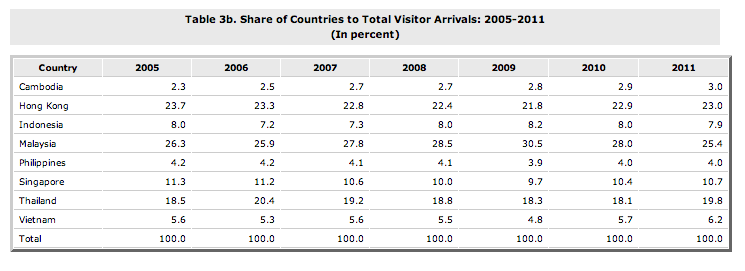The Philippine needs to be more competitive when it comes to its tourism industry, according to the latest report from the National Statistical Coordination Board (NSCB).
In the report titled “Boosting Our Economy and Sustaining Economic Growth Through Tourism,” NSCB Secretary-General Jose Ramon Albert said that based on the latest statistics of the Department of Tourism (DOT), visitor arrivals reached the 4-million mark for the first time, reaching 4.272 million in 2012, almost hitting the target of 4.5 million visitors for the year.
Visitor arrivals pertain to both foreign visitors and overseas Filipinos.
“In fact in the last three years, the number of visitor arrivals has been on an increasing trend, 16.7-percent growth in 2010, 11.3 percent in 2011 and 9.1 percent in 2012,” Albert added.
Furthermore, the data stated that the highest contributor to visitor arrivals in 2012 was East Asia, which accounted for 2.038 million visitors, which is nearly half (47.7 percent) of the total visitor arrivals for the year.
Next was North America, with 778,162 visitors, or 18.2 percent while neighboring countries of the Association of Southeast Asian Nations (Asean) accounted for 375,190 visitors, or 8.8 percent.
Meanwhile, the DOT data noted that the top three countries where the visitors came from were: Korea, accounting for 1.031 million visitors, or 24.1 percent of the visitor arrivals, United States with 652,626 visitors or 15.3 percent, and Japan with 412,474 visitors, or 9.6 percent.
“These three countries also occupied the first three places in terms of volume of visitors to the country in 2011,” the NSCB chief said.
Also, the data reported that among the top 12 countries by volume of tourists in 2012, Malaysia had the highest growth of visitor arrivals to the country at 24.8 percent, followed by Taiwan at 19.1 percent and Australia at 12 percent.
Still lagging behind
However, Albert mentioned that while the visitor arrivals in the Philippines have improved over the recent years, these figures are lower in comparison with some of its neighboring countries.
“Data show that the Philippines has still a lot of catching up to do if we want to be competitive in the global tourism scene,” he stated.
Data showed that among the eight countries in the Asean region, the Philippines came in only at seventh place.
Malaysia had the highest level of visitor arrivals in 2011 at 24.714 million, with a share of 25.4 percent, second was Hong Kong with 22.316 million visitors, or 23 percent, and third was Thailand with 19.230 million visitors, or 19.8 percent, the data added.
“Malaysia and Hong Kong have been consistently in the first two places throughout the years,” the NSCB chief further said.
Albert urged the national government, local governments and the private sector to work hand-in-hand to attain the targets in the tourism sector, and be able to contribute immensely to inclusive growth and employment generation.
“And in promoting the Philippines as a major tourist destination and in increasing our tourism competitiveness, we should not also forget about the ecological aspects/issues that have to be addressed if we want to sustain all our efforts in making tourism a driver of economic growth,” he added. ___
![]()
The Daily Newsletter
Our daily coverage of the global travel industry. Written by editors and analysts from across Skift’s brands.
Have a confidential tip for Skift? Get in touch
Tags: philippines
